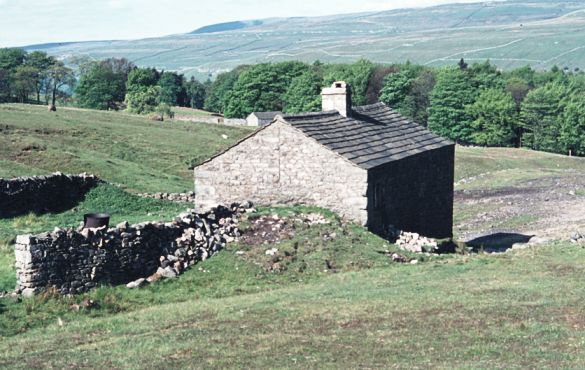Buckden – SD 933768
This mill was built by July 1704, by the Earl of Burlington and, after the High Mill was closed, was usually called the Birks Mill. As was usual around this time, the mill’s single ore-hearth was also used as a slag-hearth. In 1743, for example, David Popplewell was paid for pulling down an ore-hearth and setting up a slag-hearth. It was the only mill in the Starbotton and Buckden (sometimes called Langstrothdale) Liberty during the rest of the 18th century, and smelted ores from small mines on Springs Cam, Buckden Gavel, and what became Wharfedale mine.
In May 1741, Solomon Bean, the Grassington Barmaster, and Stephen Barrat went to Swaledale to see a stamping mill. The AD Mines did not have stamps then, and so this was probably the one near Moulds High smelt mill, at NY989019, which served the Arkengarthdale mines. Later the following year, a stamp mill was built at the Birks Mill, where it crushed slags.
Production in the Buckden liberty received a boost when the Buckden Gavel Level, begun from the gill above the High Mill in 1804, found good ore. Nevertheless, in 1814, the Duke of Devonshire’s agents conducted a trial between the Grassington Cupola and the Birks Mill, which had an ore-hearth.42 This was to settle which of the two ‘made the better produce in lead and also the expense in smelting and carriage of the ore from the mine to each place and the lead to Skipton from each place’. No allowance was made for the cost of running either smelt mill or for their depreciation. Two parcels of otherwise identical ore, each about 10 tonnes, were weighed and smelted and the results were as follows:-
Birks (Buckden Low) Smelt Mill (ore/slag-hearth)
produced 72.8 per cent at a cost of £2.53 per tonne.
Grassington Cupola (reverberatory)
produced 75.5 per cent at a cost of £2.67 per tonne.
The results were contradictory, showing the cupola to be about 3.6% more efficient but, owing to the haulage costs, 5.5% more expensive. If the latter charge had been identical, however, then the cupola would have produced lead at £1.95 per tonne, which was a considerable saving. The agents ignored the difference in haulage costs, however, and closed Birks Mill almost immediately, concentrating all smelting at Grassington.
The site of the mill is now occupied by a shooting hut, but slags are still visible. A cast iron pipe-stone, recovered by the NCMRS is on display at the Earby Mines Museum.
Further information and references can be found in:
- Gill, M.C. Yorkshire Smelting Mills Part 2, Northern Mine Research Society Memoirs 1993, British Mining No 48, pp 132-151


